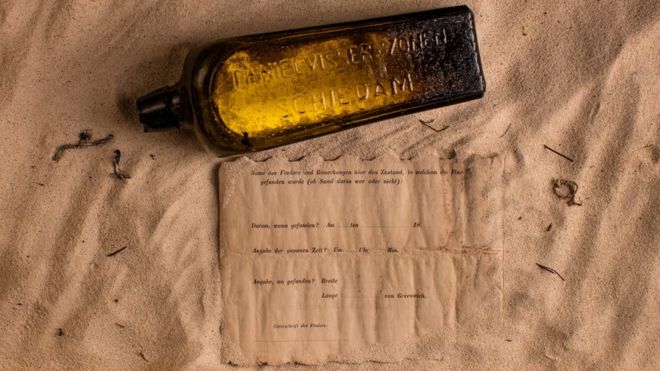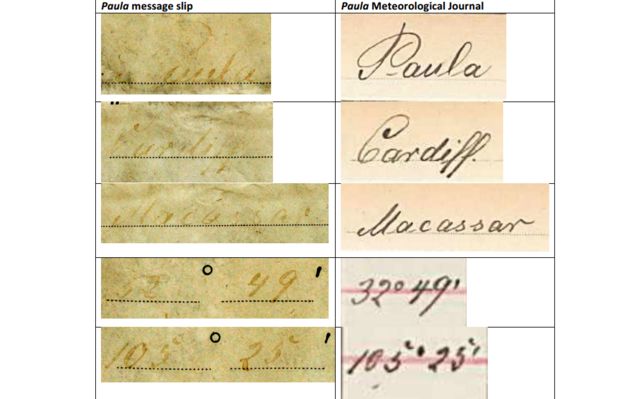Oldest message in a bottle found on Western Australia beach

Experts confirmed the bottle was jettisoned as part of a German oceanographic experiment in 1886
A Perth family has discovered the world's most established known message in a container, very nearly 132 years after it was tossed into the ocean, Australian specialists say.
Tonya Illman grabbed the container while going for a stroll around sand rises on a remote shoreline in West Australia.
Her better half Kym Illman told the BBC they discovered some paper in the jug yet had "no thought" what it was until the point when they took it home and dried it in the stove.
Specialists have affirmed it is a genuine message from a German ship.
The note in the container, which was dated 12 June 1886, was ejected from the German ship Paula, as a feature of an examination into sea and transportation courses by the German Maritime Observatory.
Beforehand, the Guinness world record for the most established message in a jug was 108 years, between it being sent and found.
'Moved up cigarette'
The Illman family were driving through a shoreline north of Wedge Island on 21 January when the auto moved toward becoming impeded in the sand, and Mrs Illman and her companion chose to go for a walk.
"Tonya saw a ton of junk on the ground, and thought she'd help get some refuse," Mr Illman told the BBC.
She found and grabbed the jug, supposing it would be decent for her bookshelf, he included.
Mr Illman said his significant other passed the jug "to our child's sweetheart, who saw what she thought was a moved up cigarette, and tipped it out with the sand".
"Tonya endeavored to unfasten the string around the paper, yet it was somewhat delicate, so we took it home and place it in the stove for five minutes to become scarce the dampness.
"At that point we unrolled it and saw printed composing. We could see the manually written ink by then, yet observed a printed message that requested that the peruser contact the German office when they found the note."
Afterward, they likewise saw black out penmanship on the note, with a date of 12 June 1886 and the name of the ship, Paula.
When they saw the date they thought it was "too implausible" to be genuine, Mr Illman said - yet they inquired about the container on the web and took it to specialists at the Western Australian Exhibition hall.
Dr Ross Anderson, Aide Custodian Oceanic Prehistoric studies at the WA Historical center, affirmed the find was valid in the wake of counseling with associates from Germany and the Netherlands.
"Amazingly, a documented pursuit in Germany discovered Paula's unique Meteorological Diary and there was a passage for 12 June 1886 made by the chief, recording a float bottle having been tossed over the edge. The date and the directions relate precisely with those on the container message," Dr Anderson said.

The penmanship on the diary, and the message in the jug, likewise coordinated, he included.
The jug was discarded in the south-eastern Indian Sea, and most likely appeared on the Australian drift inside a year, where it was covered under the sand, he wrote in his report.
A great many containers were tossed over the edge amid the 69-year German investigation however to date just 662 messages - and no jugs - had been returned. The last jug with a note to be found was in Denmark in 1934.
The container found on Wedge Island was discovered "for the most part uncovered with no type of stopper or conclusion, and was about a quarter loaded with clammy sand", and the jug seemed to have lain "covered or for the most part covered", in part loaded with sodden sand, Dr Anderson included.
Sand ridges in the territory are very versatile amid storm occasions and substantial rain, so the container could have been liable to "repetitive times of introduction" which could have prompted the plug in the jug drying out and getting to be unstuck, "while the firmly moved paper alongside an amount of sand stayed inside saved".
"The thin 7mm bore of the jug opening and thick glass would have helped to support and save the paper from the impacts of full introduction to the components, giving a defensive microenvironment ideal to the paper's long haul safeguarding," the report included.
Comments
Post a Comment